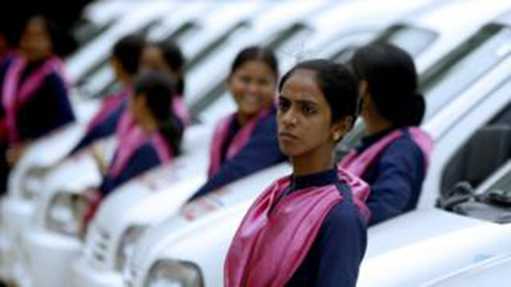印度女性就业率一直位于世界倒数几位,这两年这一趋势更有扩大之势。是什么样的原因导致了这种情况呢?

The numbers are stark - for the first time in India’s recent history, not only was there a decline in the female labour participation rate, but also a shrinking of the total number of women in the workforce.
数据很严酷——在印度近代史上,这是首次不仅女性劳动就业率下滑,同时劳动力中的女性总数也发生缩减。
Nearly 20 million Indian women quit work between 2004-05 to 2011-12.
2004年5月到2011年12月间,近两千万印度妇女放弃了工作。
The labour force participation rate for women of working age declined from 42% in 1993-04 to 31% in 2011-12.
达到工作年龄的妇女的劳动就业率从1993年4月的42%下滑到了2011年12月的31%。
Some 53% of the total drop - the largest chunk - happened among women aged 15-24 and living in villages
总下滑量中53%(占比最大的一部分)是由15-24岁的少女和居住在乡村的妇女构成的。
In rural areas, the female labour force participation rate dropped from 49% to 37.8% between 2004-05 and 2009-10.
在农村地区,女性劳动就业率从2004年5月的49%下滑到2009年10月的37.8%。
While more than 24 million men joined the work force between 2004-5 to 2009-10, the number of women in the the work force dropped by 21.7 million
尽管2004年5月到2009年10月期间,两千四百多万男性变成了劳动力,但是女性劳动力数量下降了两千一百七十万。
Using data gleaned from successive rounds of National Sample Survey Organisation and census data, a team of researchers from World Bank have attempted to find out why this is happening.
利用国家抽样调查组织和人口普查数据连续几轮收集的数据,世行银行的一个研究小组试图找出为什么会发生这种情况。
Predictable social norms are attributed to women quitting work in India: marriage, motherhood, vexed gender relations and biases, and patriarchy.
印度女性放弃工作可以归因于可预见的社会规范:婚姻,抚养孩子,令人烦恼的性别关系和偏见,以及父权制。
But they may not be the only reasons. Marriage, for example, does affect the rate of participation of women in the workforce. But in villages, the workforce participation rate of married women has been found to be higher than that of unmarried women - whereas in the cities, the situation is reversed.
但它们可能不是唯一的原因。比方说,婚姻确实影响女性劳动力就业率。但是在农村,已婚女性的劳动力就业率比未婚女性高——然而在城市,这种情况就发生了逆转。
Significantly, rising aspirations and relative prosperity may be actually responsible for putting a large cohort of women out of work in India.
引人注目地是,不断增长的生活预期和相对富裕程度可能才是印度大量妇女放弃工作的实际原因。
After calculating the labour force participation rates and educational participation rates (young women in schools) the researchers believe that one plausible explanation for the drop in the participation rate among rural girls and women aged 15-24 is the recent expansion of secondary education and rapidly changing social norms leading to "more working age young females opting to continue their education rather than join the labour force early".
在计算了劳动力参与率和教育参与率(学校中的年轻女性)后,研究人员认为,农村15到24岁女性就业率下降的可信解释是近期扩大的中等教育和快速变化的社会规范,导致“更多的工作年龄年轻女性选择继续教育,而不是趁早加入劳动力大军”。
The study says there has been a "larger response to income changes among the poor, rather than the wealthy, by sending children to school".
研究称,通过送孩子上学,穷人而不是富人的收入变化反应更大。
Also, casual workers - mainly women - drop out of the workforce when wages increased for regular earners - mainly men - leading to the stabilisation of family incomes.
同时,主要是妇女充当的临时工,在男性充当的正常赚钱者收入增加,使得家庭收入稳定时,也会放弃工作。
But dropping or opting out of the workforce to go to school and get an education may not ensure that these women will eventually go to work.
但是,放弃或选择不工作去上学或者接受教育可能无法确保这些妇女最终会上班。
After studying the relationship with the female labour participation rate and levels of educational achievements, the researchers found that having a high school-level education was "not found to be an incentive for women" to work.
在研究完女性劳动就业率和教育水平的关系后,研究人员发现,拥有高学历并不是促进女性工作的激励。
The lowest rate of participation is among those who had secured school and high school education in the cities and villages. And the rate is actually highest among illiterates and college graduates.
就业率最低的是城市和农村中拥有高等教育的女性。文盲和大学毕业生的就业率最高。
To be sure, India has a poor record of female participation in the workforce: the International Labour Organisation ranked it 121 out of 131 countries in 2013, one of the lowest in the world.
可以确定地是,印度女性就业率记录很差:2013年,国际劳工组织在131个国家中把它排在121位,世界最低的国家之一。
Also, India is not an outlier when it comes to women dropping out of the workforce.
此外,当谈到女性放弃工作时,这在印度不是什么离奇的事情。
Clearly women need better and more suitable job opportunities, outside agriculture. Rural labour markets need to offer jobs that are acceptable and attractive to women and their families.
显然,除了农业,妇女需要更好和更合适的就业机会。农村劳动力市场需要为妇女及其家庭提供可接受和有吸引力的工作。
Also, as another study says, the "ongoing decrease in the availability of farm-based work, has led to women focusing on economic activities within their households". Should home-based workers then be counted as members of the labour force?
此外,另一项研究还指出,“农业工作的可利用性持续下降,导致妇女关注家庭内部的经济活动”。那么家庭工作人员是否应该算作劳动力成员呢?





































































































